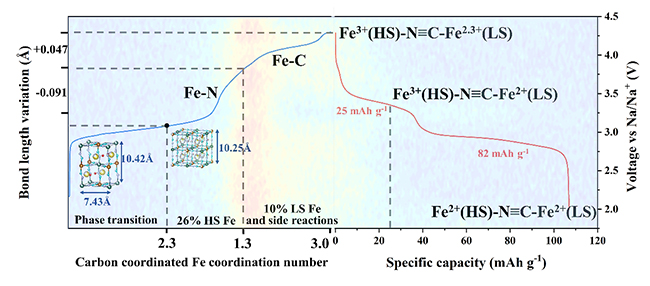Prussian blue analogues (PBAs) are featured with high theoretical specific capacity, long cycle life, environmental benignity, and low cost. They are promising as cathode materials for sodium-ion batteries (SIBs). However, the working mechanism of PBAs is still unclear, hindering their applications.
Recently, a research team led by Prof. WANG Junhu from the Dalian Institute of Chemical Physics (DICP) of the Chinese Academy of Sciences (CAS), in collaboration with Prof. LI Xianfeng from DICP and Dr. Moulay Tahar Sougrati from the University of Montpellier, revealed the charging/discharging mechanism and capacity degradation principle of Prussian blue cathode in SIBs through operando Mössbauer spectroscopy.
This study was published in Nano Energy on Feb.5.

Schematic diagram of HS/LS Fe redox mechanism and local structure changes in the electrochemical reaction process (Image by WANG Zinan)
The researchers synthesized a sodium-rich Prussian blue by co-precipitation method, and used it as a cathode for SIB. The prepared SIB showed good electrochemical performance, which could maintain 81% capacity retention after 980 cycles under 120 mA g-1.
Furthermore, they on-line observed the working process of the SIB through operando Mössbauer spectroscopy, and revealed the working mechanism of Prussian blue using low-temperature 77K 57Fe Mössbauer spectroscopy, operando X-ray diffraction spectroscopy, and synchrotron X-ray absorption spectroscopy combined with the operando Mössbauer spectroscopy.
They found that the reaction of high-spin (HS) Fe and low-spin (LS) Fe reacted stepwise. The HS Fe reacted completely and contributed to most capacity, while only part of LS Fe reacted. This was the main reason for the discrepancy between practical capacity and theoretical one.
However, they also found that LS Fe could lead to more severe local distortions with respect to the effects imposed by the same amount of HS Fe, which decreased cycling stability.
Therefore, the good cycling performance for the Prussian blue cathode material could be assigned to the tiny changes of crystal parameters and the incomplete reaction of LS Fe.
"This work provides new insight into developing of PBAs cathode materials with high capacity and good cycling stability," said Prof. WANG.
This work was supported by the National Natural Science Foundation of China, the International Partnership Program of CAS, the President's International Fellowship Initiative (PIFI) of CAS.